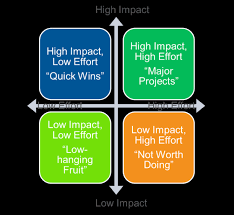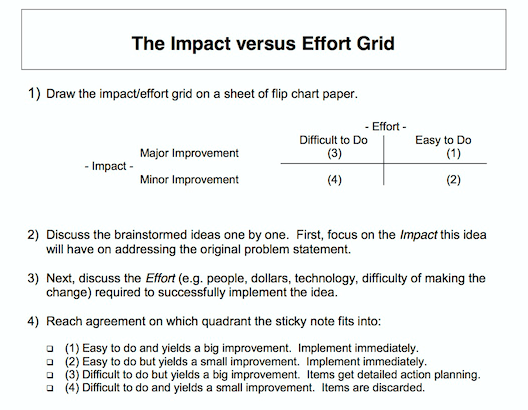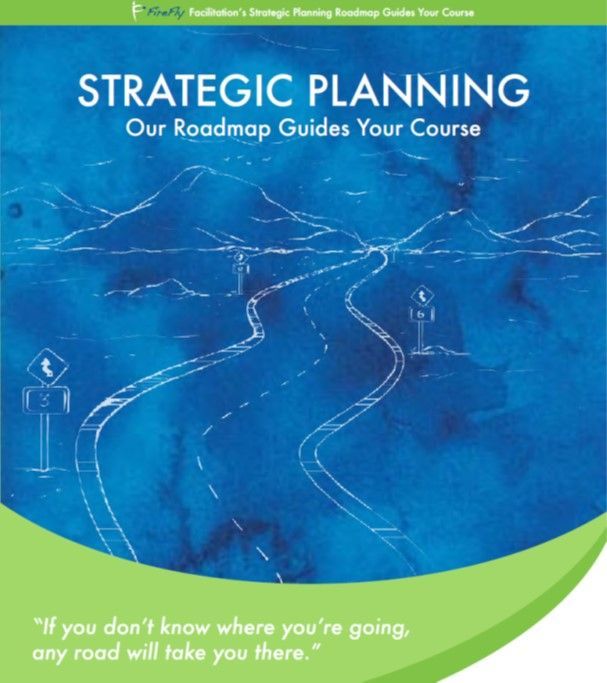Create A Plan Using The Impact versus Effort Grid
How this simple 2 x 2 matrix can simplify evaluating your brainstormed ideas
In previous posts, we discussed using techniques like MindMapping and Brainwriting to stimulate your team’s creativity and generate ideas. Now it’s time to channel all those great ideas into a viable action plan! How do you pull all that creativity together in an actionable way? We’ve got two very effective techniques to discuss: the Impact versus Effort Grid and the Decision Matrix. In this post, we’ll talk about the Impact/Effort Grid.
The Impact/Effort Grid tool is very easy to use right away since, unlike the DecisionMatrix, it does not require the creation of criteria, and the grid has already been designed. It is also perfectly suited to evaluate a large number of ideas in a small amount of time, and it can be easy to determine fairly quickly what the highest priority ideas that should be moved forward into the action-planning phase are. The DecisionMatrix, on the other hand, is ideal for more complex decisions, especially if you incorporate a weighting of the criteria.
Both of these tools bring greater objectivity and thoroughness to the process than a simple sticky dot vote does, especially since it involves the entire group in the decision making process as opposed to just majority rule. Using them—at the outset or as a backup plan—can also ease tensions when strong opinions combined with strong-willed individuals make reaching consensus on the top ideas more and more unlikely.
If you can create a two-by-two matrix, then you, too can be a consultant! This is a relatable way to introduce the Impact/Effort Grid, because that is what this tool looks like. You simply draw a large square over the whole surface of a flip chart, then draw intersecting lines to divide it into four equal quadrants. Along the horizontal axis at the top of the square, write the word EFFORT, and then write in Easy on the right side, Difficult on the left side. Along the vertical axis, write IMPACT, and then write in Major at the top, Minor at the bottom. This is what those four boxes mean, and how you should deal with the ideas that fall into each one:
- Easy Effort/Major Impact. The best of all worlds! Create a quick project plan, assign some accountabilities, and get started right away.
- Easy Effort/Minor Impact . It’s up to you and your team whether to execute on this idea or not. If you need more quick wins than you can get from the one above (Easy Effort/Major Impact), you might want to build some of these ideas into the plan, especially if people have the capacity to take them on.
- Difficult Effort/Major Impact. These ideas will need detailed action planning, so I recommend waiting to fully execute on them until the ideas above are exhausted. One caveat is that if there are not enough great ideas in the first two boxes, then you might need to get to work on these. Also, if you strongly believe that you will eventually implement these ideas, and some require a lot of up-front planning before full implementation would be possible, then you might need to get started sooner rather than later.
- Difficult Effort/Minor Impact . Who would want to do these? Discard!
Impact versus Effort is such a simple concept, and it is the perfect next step from a brainstorming session when each person wrote down their ideas on individual sticky notes. As simple as it is, though, it does require some planning, and there are processes that make it easier still.
In our next post, we’ll take a closer look at Impact versus Effort, and give you some tips to make it work for your team.







